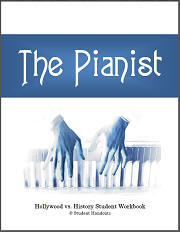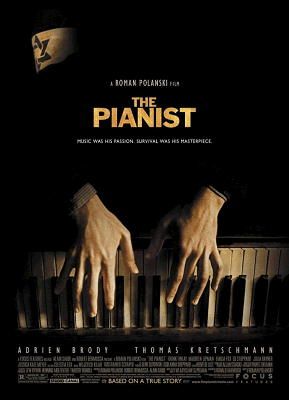| The Pianist (2002) Educator Guide |
|---|
| www.studenthandouts.com ↣ World History ↣ World War II ↣ World War II Books and Films |
|
Release date: 2002
Length: 150 minutes (2 hours, 30 minutes) Age Appropriateness Rating: The Pianist is rated "R" in the United States based on violence and some strong language. However, while the violence present in this film is most definitely disturbing, it is necessary to illustrate this Holocaust memoir. This film is appropriate for mature high school students studying the Holocaust under the Nazis during World War II. Creators and Stars: Adrien Brody, Andrzej Blumenfeld, Cezary Kosinski, Daniel Caltagirone, Daniel Szpilman, Ed Stoppard, Emilia Fox, Frank Finlay, Jessica Kate Meyer, Joachim Paul Assbock, John Bennett, Julia Rayner, Maureen Lipman, Michal Zebrowski, Morgane Polanski, Paul Bradley, Popeck, Richard Ridings, Roman Polanski, Ronald Harwood, Ronan Vibert, Roy Smiles, Ruth Platt, Thomas Kretschmann, Wladyslaw Szpilman. Historical Accuracy: This film is based on Wladyslaw Szpilman's memoir, The Pianist: The Extraordinary True Story of One Man's Survival in Warsaw. The movie's screenplay is pretty accurate to the book, minus a few minor personal items, such as a flirtation between Wladyslaw and Dorota that did not actually exist. The realistic depictions of life in the ghetto, and of what it was like for a Jew in hiding in Warsaw, more than make up for these unimportant inconsistencies. The director, Roman Polanski, was himself (while a child) forced to live in hiding in Poland during World War II; it's hard to get it wrong when you were there.  Review: The Pianist won three Academy Awards: Best Director (Roman Polanski), Best Actor (Adrien Brody), and Best Adapted Screenplay (Ronald Harwood). Artistically, this film is a joy to watch—beautiful cinematography, brilliant acting, exemplary set design, and everything you would expect from one of the best films ever made.
Review: The Pianist won three Academy Awards: Best Director (Roman Polanski), Best Actor (Adrien Brody), and Best Adapted Screenplay (Ronald Harwood). Artistically, this film is a joy to watch—beautiful cinematography, brilliant acting, exemplary set design, and everything you would expect from one of the best films ever made.
How is The Pianist different from other Holocaust films? Certainly, we all know that the Germans were the bad guys, and their victims—here, Jews and Poles who resisted the Nazis—were the good guys. The Pianist realistically blurs the lines between good and evil, vividly portraying Jews who collaborated with the Nazis within the Warsaw ghetto, and a German officer who helped Wladyslaw. The Nazis are still evil, and the Jews are still their innocent victims, but not everything in this film (or in real life) is plainly black and white. It's a level of insightful characterization reached very rarely in Holocaust (or any other historical) literature and films, most notably in Anatoly Kuznetsov's Babi Yar. By showing that most of those who lived through World War II in Europe were simply trying to survive, the crimes committed against millions become easier for viewers (and readers) to understand. Notably, both Babi Yar and The Pianist are firsthand accounts of the Holocaust written shortly after World War II by men who were simply eager to describe all that they had seen, heard, and lived through, long before the Holocaust had taken root as a theme in literature and film. Perhaps this is why their honesty is so painful yet touching to read and watch. Wladislaw Szpilman (played brilliantly by Adrien Brody) is a Jewish pianist who survives the war, yet he is not presented as a hero. He spends the entire film surviving rather than fighting. But what choice does he have? As a Jew living in a country occupied by the Nazis, Szpilman is marked for extermination from the beginning of the film. Watching The Pianist, we see the Second World War as Szpilman sees it. Scenes of street fighting and skirmishes are filmed from Szpilman's vantage point, and viewers learn no more about the current state of the war than Szpilman learns. Unfortunately, the length of The Pianist (a full two-and-a-half hours) makes it an unrealistic choice for classroom viewing. Brief excerpts of the movie fail to deliver the full impact of Szpilman's story. We strongly recommend The Pianist for home viewing.  Click here to print our nine-page workbook to accompany this film.
Click here to print our nine-page workbook to accompany this film.
It includes a geography "pre-viewing" activity, to introduce some of the places students will encounter in the film. The "viewing" activities involve taking notes on each major character and answering questions (in chronological order). The "post-viewing" activity involves four critical thinking essay questions. Answer Key Geography: (1) On map (2) On map (3) On map (4) On map (5) On map (6) On map (7) Answers will vary (8) Great Britain and France Characters: Answers will vary. Students should be able to describe the role that each character played in Wladyslaw's life, and what ultimately became of each. Timeline: (1) October 31, 1939: The Szpilmans and other Jews are relocated to the Warsaw ghetto. (2) March 15-21, 1942: The Szpilmans (minus Wladyslaw) and many other Jews are cleared out of the ghetto and sent to concentration camps. Questions: (1) Answers will vary, but may include: wearing the Star of David armband at all times; bowing to Germans; walking in the gutter as opposed to on the sidewalk; relocated to the ghetto; not allowed in restaurants; can't enter public parks; can't sit on public benches (2) Henryk sells things (books); Wladyslaw plays piano at a restaurant; father gets a work assignment at a sewing factory; mother and sisters sort through the luggage of those shipped to concentration camps (3) Jewish policeman (Itzak Heller) pulls him from the line (4) Construction (brick work, then weighing nails) (5) Hidden in sacks of food (6) He breaks dishes, alerting a neighbor to his presence (7) The man who is soliciting donations on his behalf is not delivering food regularly (8) The Germans fire at the building, creating a hole in the wall between Wladyslaw's apartment and the apartment next door (9) He enjoys listening to Wladyslaw play the piano (10) They mistake Wladyslaw for a German soldier because of the coat he is wearing (11) 2000 (aged 88) (12) He died in a Soviet POW camp in 1952 Essay Questions: Answers will vary. Click here to enlarge the official film poster. Click here to purchase the DVD. |
 |  |  |  |  |
 |  |  |  |  |
 |  |  |  |  |
 |  |  |  |  |
 |  |  |  |  |
 |  |   |  |  |
 |  |  |  |  |
 |  |  |  |  |
 |  |  |  |  |
| World War II Books and Films | World War II Outlines and PowerPoints |
| World War II Study Games | World War II Maps and Pictures |
| World War II Miscellany | World War II Worksheets |
| www.studenthandouts.com ↣ World History ↣ World War II ↣ World War II Books and Films |








